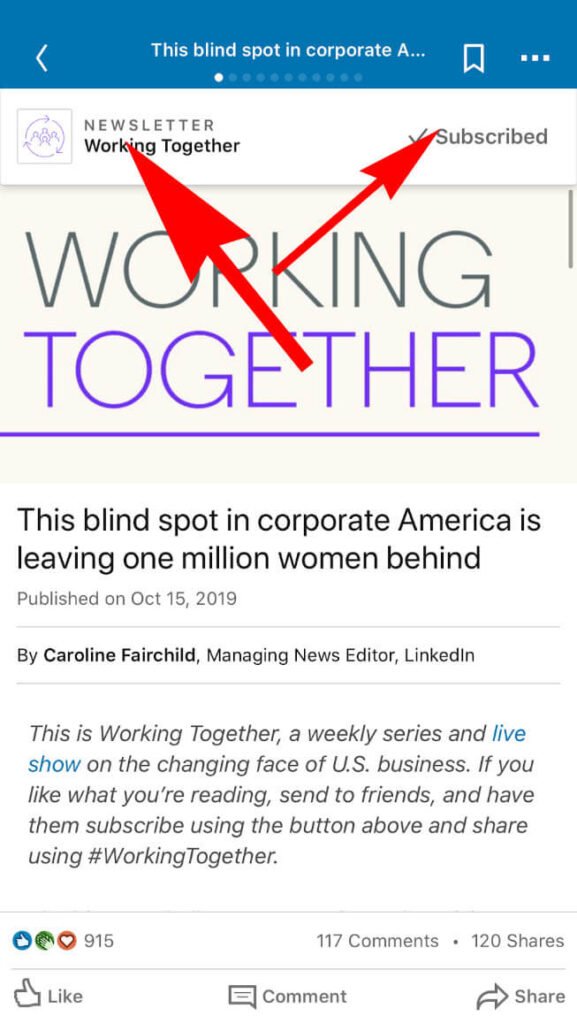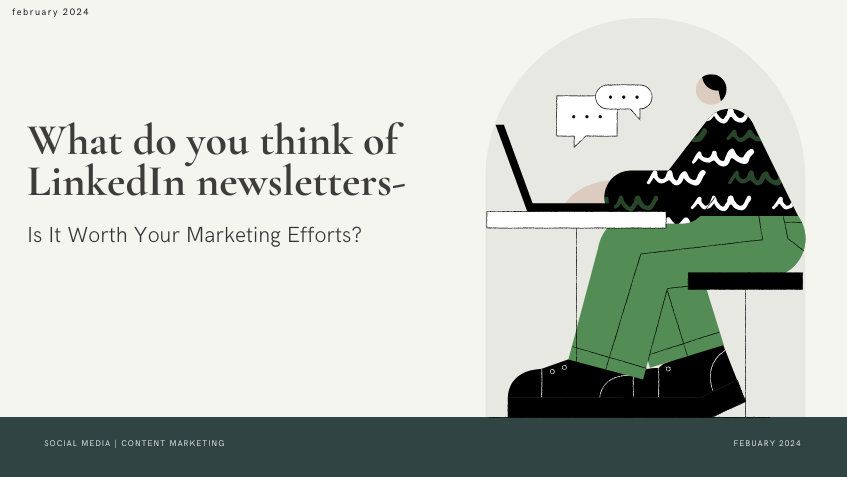Do LinkedIn newsletters actually live up to the hype? Continue reading as we discuss their advantages and disadvantages as well as how to utilize them wisely in your content marketing.
Are you getting more and more solicitations to subscribe to newsletters in your LinkedIn notifications? We are feeling you.
It seems like everyone has launched a LinkedIn newsletter since the network allowed marketers to establish their own. “Should I be using this too for my business?” is a question that it raises.
Or will receiving updates from LinkedIn become as unnecessary as that expensive satellite radio you bought along with your new car? Initially thrilling, but ultimately overlooked and underutilised… 😅
After we go over all the advantages and drawbacks of a LinkedIn newsletter, you’ll be able to decide if it’s the marketing tool you’ve been waiting for.
But let’s begin with the Basics.
What Is a LinkedIn Newsletter?

To put it simply, a LinkedIn newsletter is published immediately within the LinkedIn platform and is comparable to a standard email newsletter.
Practically everyone can make one or subscribe to one by now. After subscribing, users receive email and in-app notifications each time you release a new newsletter.
This leads us to our next query: What distinguishes LinkedIn newsletters from articles on LinkedIn?
The primary distinction is that articles appear on your timeline as soon as they are published. Your connections have to navigate through their feed to find it, just as with any other post of yours.
Conversely, subscribers are alerted by email and LinkedIn as soon as you post a newsletter, which greatly raises the likelihood that people will find and interact with your material.
As a thought leader in the field, you are invited to regularly post a LinkedIn article on a professional subject that you are passionate about and have extensive knowledge of as the writer of a LinkedIn newsletter. Linkedin users have the option to subscribe to your newsletter and get updates whenever you post a new article.
Put another way, your “newsletter” is actually a LinkedIn article that is maintained on LinkedIn and is aided by notifications from LinkedIn. It’s not sent by email.
Do LinkedIn Newsletters Fit Into Your Content Marketing Plan?
Are LinkedIn newsletters really worth all the hype?
yes and no. 🤷
Benefits of LinkedIn Newsletters for Businesses

Prior to breaking the terrible news to you, let’s examine all the reasons why you SHOULD think about starting a LinkedIn newsletter:
Helps Build Authority
Customers want to feel confident in the businesses they do business with more than before.
Establishing oneself as an authority in your field is the first step in developing trust, and here is where a LinkedIn newsletter can help.
Your audience will start to regard you as a reliable information source if you consistently provide high-caliber, valuable material, especially if they are in need of the goods or services you offer.
Helps Increase Engagement
Similar to other social networking sites, not every contact on LinkedIn will interact with your material frequently, if at all.
So, how can you locate extra individuals who actually connect with the subjects you discuss?
By “cleansing” your contact list, a LinkedIn newsletter may assist you in doing exactly that.
The only individuals who will sign up for your newsletter are those who can connect to and are interested in the kind of information you produce. which translates to increased involvement.
Additionally, once your email subscribers see how amazing the material you provide is, they’ll want to read your other published pieces as well. Bravo 💥
Helps Boost Brand Awareness
If you have cultivated your LinkedIn network appropriately, the majority of your contacts ought to be business associates.
However, after connecting, a lot of them will probably forget about you.
You may effectively maintain professional relationships and expose your brand to the appropriate audience by subscribing to a LinkedIn newsletter. It’s a fantastic way to remind them of what you do and to highlight the answers you offer.
Disadvantages of a Business LinkedIn Newsletter
Sadly, life is not all sunshine and sausages over in the land of LinkedIn newsletters.
Let’s examine the primary restrictions on LinkedIn newsletters in more detail:
You Can’t Collect Emails
The greatest drawback of a LinkedIn newsletter is that it does not provide you access to your subscribers’ emails—the holy grail of marketing.
Individuals who sign up for a LinkedIn newsletter do not provide you with their email addresses, in contrast to traditional email newsletters. That contact list you intended to save in your CRM system for purposes like cold outreach or bespoke audiences can now be discarded.
Even if you have 10,000 subscribers to your LinkedIn newsletter, you have no idea what to do with them (how frustrating is that? 🥴️).
It is thus necessary to find a way to get the LinkedIn newsletter subscriber to sign up for your internal newsletter, podcast, or blog as well. Naturally, bear in mind that this can deter someone from subscribing to more of your publications out of concern about excessive email correspondence.
Extremely Limited Analytics
As of right now, the only analytics available through a LinkedIn newsletter are the most basic ones—views, impressions, and engagement.
No more information is accessible to help you know, for instance, if they read the full newsletter or just the first line before leaving.
Understanding your LinkedIn newsletter’s view count and impressions alone won’t provide you a complete picture of whether or not it is turning subscribers into prospects.
Additionally, since people are finding your information via the LinkedIn network, if they are interested, they must click on another link to visit your website. And maybe after they’re on your website, you can direct them to the appropriate page.
However, the likelihood that someone would lose interest and opt out entirely increases with the number of clicks and links you force them to follow. If you’re thinking of launching a LinkedIn newsletter, you have to be prepared to take that chance.
You won’t be able to collect data to gauge user activity and, eventually, return on investment (ROI) until you install a tracking tag on your website, as you would typically do with Google Analytics.
Important information to assist you decide if it’s worthwhile to invest time and energy in a LinkedIn newsletter.
How to Include Newsletters From LinkedIn Into Your Content Marketing Plan
Which newsletter is better, LinkedIn or email? 🤜🤛
Okay, it makes sense. Email newsletters are obviously more better, mostly because they allow you to create an email list that you can retain and use as you like.
But why not employ both is the true question you should be asking yourself?
To increase website and email newsletter traffic, start a LinkedIn newsletter.
Direct viewers to the channels you control instead of creating a community that you can lose in the blink of an eye.
It’s important to convey insightful information in the LinkedIn newsletter, but it will require careful consideration to avoid giving out too much. That’s the secret.
Your goal is to provide them just enough value to pique their interest in your company.
| In simple terms: Email newsletter = Value bombs 💣 LinkedIn newsletter = Lighter, but still interesting and valuable content |
Content Ideas We Utilise for Our Clients’ Linkedin Newsletter Content Strategies
- Link snippets to your most recent blog entries (repurposing is your best friend)
- Links to previous webinars (please provide a summary)
- Links to current videos and podcasts (also includes show notes)
- Case Studies
- Fun Q&A sessions with the employees
- Highlights of your voluntary efforts, pro bono work, and community service
- updates of your most recent hiring
- Recent media attention
- upcoming webinars and events
- Information about your programmes for women’s initiatives and diversity
Extra tip:
Using both corporate pages and personal accounts to send LinkedIn newsletters might prove to be a highly successful tactic.
Personal LinkedIn profiles, such as those of C-level executives or sales people, can work in tandem with your company’s LinkedIn newsletter to enhance each other’s reach and possibly expand it.
Final Verdict
Now that the decision has been made, everyone should go back to their seats. 🧑⚖️

To sum everything up, a LinkedIn newsletter is a great choice for smaller businesses or freelancers who:
- Don’t have an existing database but have a substantial number of LinkedIn followers.
- Don’t have the budget and/or the technical know-how to use more advanced email marketing and CRM platforms like Hubspot and Active Campaign.
- Don’t have the necessary GDPR procedures required to maintain an email contact list.
Consider why you want to start a LinkedIn newsletter and if it will provide outcomes that are comparable to or superior to what you are now doing before you begin.
Ultimately, would it make sense to direct users to other locations where your material is available if you are unable to obtain their emails? Or will increasing the amount of textual and video content you produce work just as well to get people to your website?
Consider the benefits and drawbacks of starting a LinkedIn newsletter for yourself. If you need assistance, don’t hesitate to ask! Get in touch with us by clicking here.
Additionally, as today’s topic calls for it, don’t forget to check us out on LinkedIn as well.
Growth Star, till next time 👋
If this post was helpful to you, please consider sharing it with others.





Leave A Comment